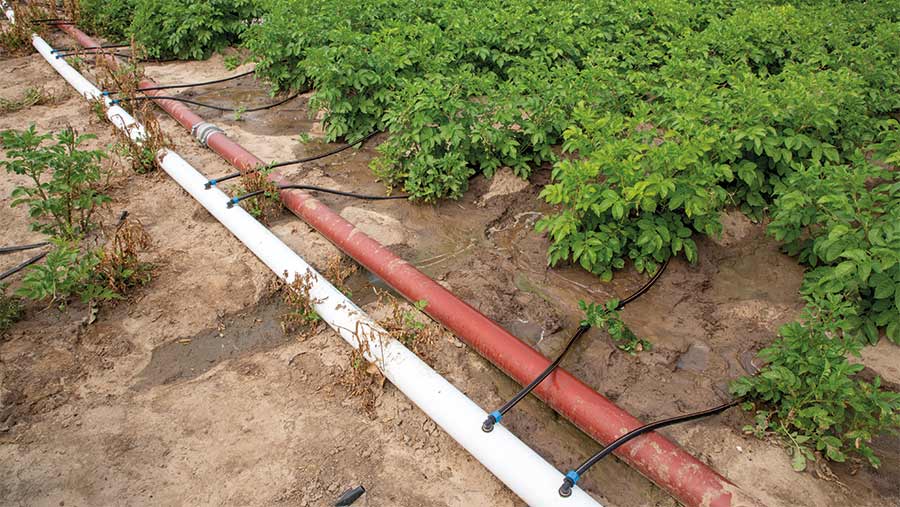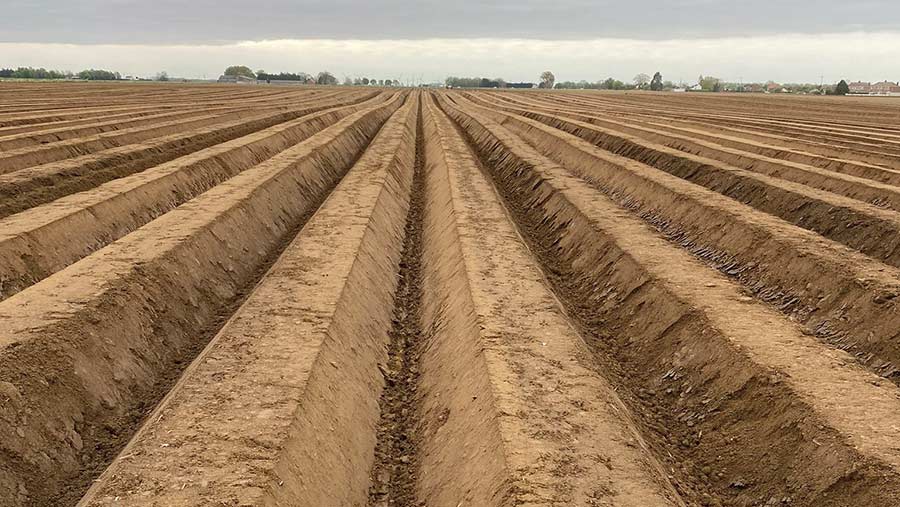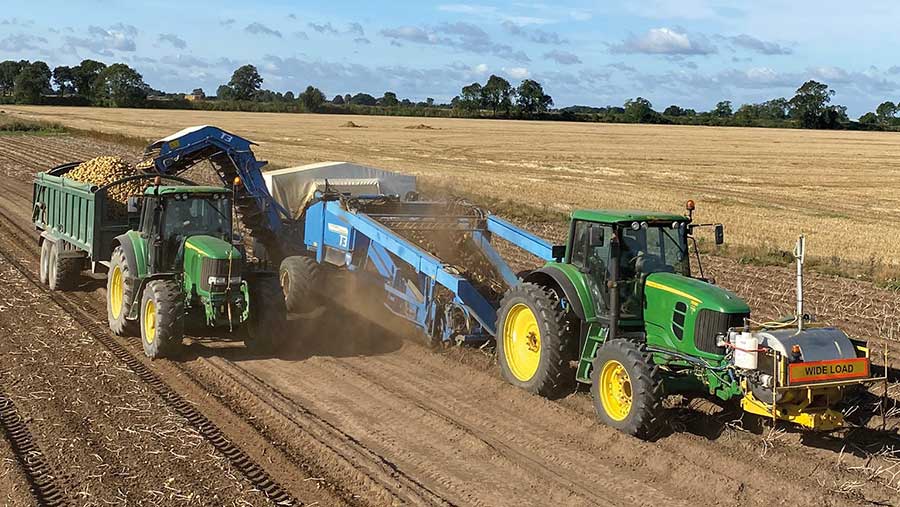How a trickle approach can cut potato irrigation energy costs
 © Gary Naylor
© Gary Naylor Diesel and electricity are the main energy sources used to pump water through irrigation systems.
It was, therefore, a double whammy when last year’s high prices hit potato growers in what was one of the driest summers on record.
It may have led some to think about alternative forms of irrigation, such as trickle (also known as drip), which uses less water and energy than its overhead counterparts. But the choice is not straightforward.
See also: 4 tips for successful potato establishment this spring
Irrigating 472ha of potatoes, onions, parsnips and carrots cost Andrew Blenkiron – who farms south of Thetford in Suffolk – £230,00 in electricity last season, compared with £70,000 the season before (in 2021).
He uses 20 reels: 18 rain gun and two boom irrigators. “Trickle irrigation is incredibly expensive to put in, and, for potatoes, it doesn’t necessarily wet the soil as effectively as overhead,” he says.
“There is also the labour cost – rolls of pipe to lay every row and wrapping it up when the season has finished, as well as tape disposal costs.
“It is better in terms of water use efficiency, but you need to balance that out. At the moment, for us, it doesn’t pay.
“And with retailers not paying what it costs to grow potatoes, currently, it is difficult to justify any new investment.”
Andrew Howseman, managing director at Howseman Agriculture, which installs drip irrigation for potatoes and onions, says this irrigation method has the potential to reduce diesel/electric use by 30%.
But other considerations – such as yield, water use efficiency, crop quality and labour – will come higher up the list when growers are deciding whether to opt for drip irrigation.
“It is possible to achieve the same yield of potatoes with 40% less water,” says Mr Howseman.
“We used 97mm of water in a drip system, which produced 67t/ha. A rain gun system on a neighbouring farm used 160mm of water, producing 69t/ha,” he adds.
“In another example, drip tape applied 10% less water compared with a rain gun, and achieved 17% more yield.”
Melvyn Kay, executive secretary at the UK Irrigation Association, believes there are pros and cons with trickle irrigation. “The implications are that it saves a lot of water, but I’m not sure it does.”
He adds that most farmers who have switched to trickle grow high-quality, premium-grade produce to meet supermarket requirements, rather than to save water.
“Trickle wetting patterns can be difficult to establish in newly formed ridges and beds, because the soil may not be compact enough,” says Mr Kay.
“So, some farmers use overhead irrigation initially to wet up the soil profile. Trickle irrigation is perceived as an environmentally friendly irrigation method and this has marketing advantages.”
Mr Kay says trickle is an option worth considering for energy saving, but farmers still have to pump the same amount of water as a sprinkler, just at a lower rate and all day rather than a higher rate for an hour or two.
“In-field capital costs for trickle are much higher than for rain guns, but recurrent costs are often much lower, particularly as energy prices rise.
“So, look at both the capital and recurrent costs to get a true picture.”
Case study: David Matthews, G&D Matthews, Lincolnshire
Irrigation contractor and specialist grower, David Matthews, of G&D Matthews in West Pinchbeck, south Lincolnshire, has worked with trickle irrigation for years.
He says it is possible to get the same or better results with half the amount of water used in overhead irrigation.
“If you are only pumping half the amount of water, you are clearly saving energy.
“The first saving is in the amount of water needed, and the second is that the system requires less pressure to work,” he explains.
“These factors add up to a very significant fuel (diesel) saving, of up to 70%, to deliver the same results or better.”
Where water availability is a limiting factor – for example, if a reservoir is only half full – a boom system would use it all up on half the crop area, compared to trickle irrigation, notes Mr Matthews.
But there are other factors to consider.
“If you go on to trickle, you have to lay it out, whether you are using it or not. With a boom you can set it up, take it down, and leave it in the shed if you’re not using it.”

© David Matthews
Mr Matthews used to grow 160ha of maincrop potatoes using trickle irrigation, but has reduced the area latterly.
“If water is not a limiting factor, booms are easier and more cost effective. But if water is a limiting factor, I would move back to more trickle irrigation,” he says.
His trickle irrigation system uses disposable tape, which is laid approximately 40mm below each ridge after planting.
The silty soils are prone to capping, so this approach means that irrigation can continue under the cap to control soil moisture and prevent scab during tuber initiation.
Irrigation is scheduled using an Enviroscan on 15ha blocks.
“We normally irrigate on a one- to three-day interval and have the capacity to irrigate the entire area in 24 hours, if needed.
“If it rains, we can delay the next irrigation without worrying about keeping up with crop water demand. We also use the system to apply fertiliser and nutrients with the irrigation water.”

© David Matthews
Energy special
Farmers Weekly’s energy special issue arrives on doormats on 7 April 2023. To read up on all the latest energy stories included in this issue, visit our Energy Special hub.
